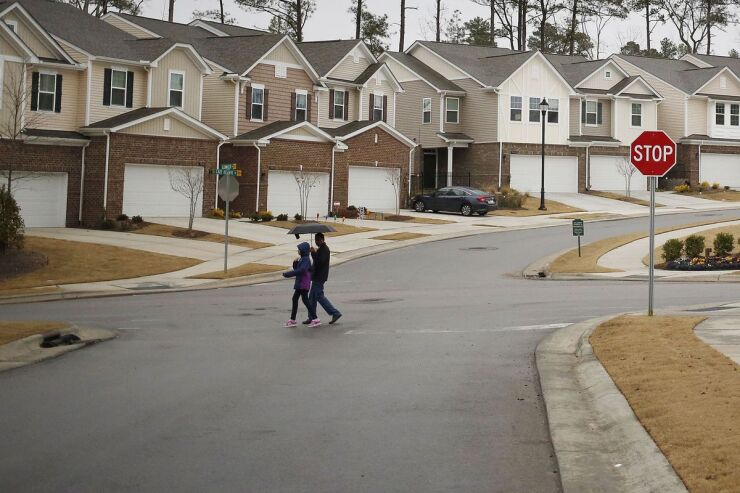Sales of previously owned homes declined to a one-year low in August as affordability continued to hamper demand and Hurricane Harvey caused a slump in Houston-area purchases, a National Association of Realtors report showed Wednesday.
Contract closings fell 1.7% month-to-month to a 5.35 million annual rate (the estimate was 5.45 million). Purchases in Houston decreased 25% year-to-year; excluding Harvey's effect, sales would have been "flat," according to NAR's chief economist.
The median sales price rose 5.6% year-to-year to $253,500. Inventory of available properties decreased 6.5% year-to-year to 1.88 million, marking the 27th consecutive year-on-year decline.
While decreased purchase activity in Houston helped push down the sales count nationwide, and may continue to do so in coming months, residential real estate is struggling to improve because of declining affordability, NAR said in the report.

Housing data may be volatile for several months in the wake of Harvey and Irma. As a result, U.S. sales in 2017 will probably be weaker than they were last year, according to the group, which plans to issue a revised forecast next week. A pause in both sales and construction in Texas and Florida as clean-up efforts continue will probably give way to improving demand later this year and into next, according to economists.
Even before the storms, home price growth was exceeding wage gains because of lean inventory, crimping affordability for some and leaving buyers with fewer properties to choose from. At the same time, a steady job market and still-low borrowing costs remain sources of support for the housing recovery.
Existing-home sales account for 90% of the market and are calculated when a contract closes. New-home sales, considered a timelier indicator though their share is only about 10%, are tabulated when contracts get signed.
"It's the lack of inventory that's pushing up prices," Lawrence Yun, NAR's chief economist, said at a press briefing accompanying the report. "Consumers are feeling their budgets are being constrained because of housing costs."
At the same time, "whatever is showing up is being snatched up quickly" by buyers, Yun said.
August purchases dropped 5.7% in the South, which includes the Texas market, to the lowest level since November 2015. The decline was largest among the four regions; sales in West fell 4.8%.
At the current pace, it would take 4.2 months to sell the homes on the market, unchanged from the prior month and down from a year earlier; the Realtors group considers less than a five-month supply consistent with a tight market.
Single-family home sales decreased 2.1% to an annual rate of 4.74 million. Purchases of condominium and co-op units rose to a 610,000 pace. First-time buyers made up 31% of all sales, a one-year low, compared with 33% the prior month; 40% is "normal" share, Yun said. Homes typically sold in 30 days compared with 36 days in August 2016; 51% of homes sold in August were on the market for less than a month.




